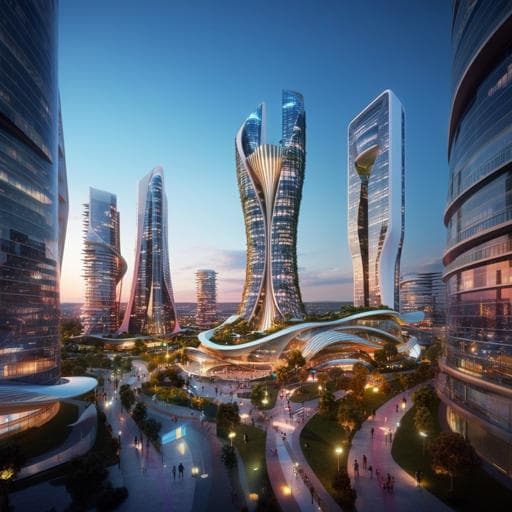
Earth Sciences
Global urban structural growth shows a profound shift from spreading out to building up
S. Frolking, R. Mahtta, et al.
This study by Steve Frolking, Richa Mahtta, Tom Milliman, Thomas Esch, and Karen C. Seto explores the intriguing transition in global urban building growth patterns from horizontal to vertical development, revealing critical implications for material use and urban living.
~3 min • Beginner • English
Introduction
Urban built environments increase building volume through lateral expansion (conversion of nonurban land), infilling (developing vacant land within cities), and vertical growth (replacing low-rise with taller buildings). Three-dimensional urban structure strongly influences greenhouse gas emissions, material demand, and urban climate, yet there is limited empirical evidence on how the vertical dimension of global urban areas has evolved over decades. Remote sensing studies have traditionally emphasized two-dimensional outward growth measured as built fraction (BF), which cannot directly capture building height or vertical growth. This study addresses the knowledge gap by asking how global urban growth dynamics have changed over the past three decades, specifically testing whether cities have shifted from predominantly outward expansion to vertical development. The purpose is to provide a consistent, global, multidecadal characterization of 3D urban growth using independent satellite-based measures, with implications for energy use, materials, climate, and urban living.
Literature Review
Earlier remote sensing research typically characterized urbanization as lateral growth using 2D metrics such as built fraction due to lack of 3D information. Population density was used as a proxy for verticality decades ago, but direct remote sensing of urban vertical growth is relatively recent. Global remote-sensing-based studies of vertical growth have been limited to about a decade of change, with recent SAR methods demonstrating multi-year 3D change for selected metropolises. Several global high-resolution 3D datasets provide single-time snapshots, and a recent longer-term vertical trend analysis is limited to Beijing using Landsat backcasting. Prior global backscatter studies by the authors combined a single scatterometer (QSCAT) with an independent BF dataset to characterize urban growth in the 2000s, identifying spatial differences but not changes in growth rates over time. Microwave backscatter is sensitive to urban structure via dihedral corner reflector scattering and correlates with building height and volume, but alone cannot disaggregate lateral, infill, and vertical growth within coarse grid cells. This study advances the literature by assembling multidecadal backscatter from ERS (1990s), QSCAT (2000s), ASCAT (2010s) and coupling it with multidecadal WSF-evo BF, enabling analysis of changes in growth rates and typologies across 1,550+ cities from the 1990s through the 2010s.
Methodology
Study domain and gridding: The spatial domain uses global Morphological Urban Areas (MUAs) for 1,567 urban areas in 151 countries. MUAs aggregated by Taubenböck et al. are overlaid with a 0.05° lat/lon grid (~5 km), including all cells intersecting each MUA polygon. Five MUAs lacking either backscatter or WSF-3D data were excluded and grid cells with ≥50% open water were masked. The final dataset contains 34,880 urban grid cells (~890,000 km²). Results were aggregated to 12 global regions, with Africa and Other Asia further partitioned into subregions.
Built fraction (WSF-evo): WSF-evo settlement built fraction (1985–2015) was aggregated to 0.05° resolution. Decadal BF increase rates were computed per grid cell as ABF_1990s = (BF_2000 − BF_1993)/7, ABF_2000s = (BF_2009 − BF_1999)/10, ABF_2010s = (BF_2015 − BF_2010)/5.
Microwave backscatter (PR): Seasonal (summer) urban backscatter (σ° in dB) at 0.05° resolution from three scatterometers—ERS (1993–2000, C-band), QSCAT (1999/2000–2009, Ku-band), ASCAT (2007–2021, C-band)—was converted to power return ratio PR = 10^(σ°/10). To avoid sensor offsets, continuous PR series were not constructed; instead, per-decade linear trends were estimated separately: ERS (1993–2000), QSCAT (1999–2009 NH; 2000–2009 SH), ASCAT (2010–2021). Intercalibration aligned ASCAT trends to QSCAT using the 2007–2009 mean PR ratio per grid cell. ERS trends were intercalibrated to QSCAT using mean PR ratios (1999–2001 NH, 2000–2002 SH), recognizing limited overlap years.
Bivariate growth classes: For each decade and grid cell, BF trend and PR trend were jointly binned into four classes: (1) slow (low ΔBF/Δt, low ΔPR/Δt), (2) outward (high ΔBF/Δt, low ΔPR/Δt), (3) upward (low ΔBF/Δt, high ΔPR/Δt), and (4) up-and-out (high ΔBF/Δt, high ΔPR/Δt). Spatial distributions were analyzed globally, regionally, and by city size.
Acceleration analysis: Decadal changes in growth rates (acceleration/deceleration) were assessed by comparing BF and PR trends between the 1990s→2000s and 2000s→2010s at regional and city scales.
k-means clustering: Independent per-decade k-means clustering of all grid cells (n=34,880) grouped grid cells using initial state (year 1993/2000/2010 PR and BF) and decadal growth rates (ΔPR/Δt and ΔBF/Δt). Five clusters per decade were generated and then mapped across decades to define seven unique typologies: budding, budding2 (1990s only), outward (1990s/2000s), slow-up-and-out (2010s only), fast-up-and-out (2000s/2010s), upward (all decades), stabilized (all decades). Interdecadal transitions were traced to study evolution in typologies.
Validation with floor area: Annual aggregate PR (sum over urban grid cells) and mean BF were compared to independent building floor area datasets: IEA global totals (2000–2021; with advanced vs emerging/developing breakdowns for selected years), and national/municipal completed new floor area time series for China (1985–2021), Beijing (1990–2020), and Shanghai (1978–2019), using accumulated new floor area as a proxy for increasing building volume.
Auxiliary 3D comparison: WSF-3D (building height 2012, fraction 2019, volume derived) aggregated to 0.05° and smoothed with 3×3 mean filter were compared with temporally matched ASCAT PR for 12 representative MUAs to corroborate spatial correlations with building height/volume.
Key Findings
- Mean annual BF and PR increased in essentially all regions and across 1,550+ cities over the three decades, but growth rates diverged: BF growth rates generally decreased over time, while PR growth rates increased across most regions and city sizes.
- Global shift from outward to upward growth: Many large cities transitioned from rapid BF with slow PR (outward) in the 1990s to slow BF with rapid PR (upward) by the 2010s; some experienced rapid growth in both (up-and-out). The transition often began in urban cores of megacities and spread outward; Dhaka was an exception with negligible pattern.
- Regional patterns: Along an arc from East Asia → China → Southeast Asia → India, the shift from outward to upward growth occurred with a temporal lag. China exhibited extensive up-and-out and upward growth and accounted for 56% of global area with rapid growth in one or both metrics. In India, rapid growth (outward or up-and-out) was largely confined to large cities (>5M) and primarily in the 2010s. Europe showed negligible transition (1990s–2010s), and Latin America’s building growth slowed over the period.
- City-size dependence: In the Asian arc, median PR trends generally increased with city population and with time, with some exceptions in the largest city size bins in East Asia and China (2000s–2010s) and India (>10M cities lower PR trend than 5–10M). Median BF trends typically increased with city population but decreased over time (exceptions: no population trend in East Asia; in China, BF trend rose in 1990s→2000s, then showed no population trend in the 2010s for cities <10M). In India, BF trends peaked for 5–10M cities.
- Quantitative global shifts (Table 1):
• Share of urban grid cells with slow growth fell from ~80% (1990s) to 74% (2010s); in China, slow-growth area dropped from 70% to 33% of urban area.
• Among rapid-growth categories, outward dominated ~80% in the 1990s but only 28% in the 2010s.
• From the 1990s to 2010s, outward growth area decreased by ~56%, while upward growth area increased by ~400% and up-and-out area by ~570%.
• Advanced economy countries saw no net increase from slow to rapid growth categories over the decades.
- Acceleration/deceleration (Fig. 3): PR growth accelerated strongly in China, the Middle East, and East Asia from the 1990s→2000s, and in Africa from the 2000s→2010s. BF growth mostly decelerated; China showed a notable BF acceleration in the 1990s→2000s, then slight deceleration yet remaining higher than other regions. West Africa was the only subregion with accelerating BF growth from the 1990s→2010s.
- City exemplars: Most large cities had accelerating PR and decelerating BF, with exceptions such as Lagos+ (BF accelerating through all decades; PR only accelerating in 2010s) and Beijing+ (large PR acceleration 1990s→2000s, slight decline afterward; BF accelerated 1990s→2000s then decelerated).
- Typologies (k-means): The largest share globally was ‘budding’, declining from 64% (1990s) to 47% (2010s). ‘Stabilized’ increased from 18% to 24%. ‘Outward’ grids in the 1990s/2000s often transitioned to ‘slow-up-and-out’, ‘fast-up-and-out’, or ‘stabilized’ in the 2010s. Fast-up-and-out grids in the 2000s/2010s were predominantly in China; by the 2010s, small shares appeared in West Africa and Southeast Asia. ‘Upward’ declined in East Asia/Europe over time (transitioning to stabilized) but grew in China and, to a lesser extent, Southeast Asia, other Asia, Africa, India, and the Middle East.
- External validation: Aggregate PR and mean BF correlated with independent floor area measures at global, regional, and city scales. In China, Beijing+, and Shanghai+, the BF increase associated with growing floor area slowed recently while PR continued rising, consistent with increasing verticality.
- Case of destruction: In Syrian cities (early 2010s), bombing reduced PR (loss of dihedral reflectors/volume) without corresponding declines in BF, demonstrating different sensitivities of the two metrics.
Discussion
The analysis demonstrates a common city-building process with distinct phases aligned with economic development stages, extending beyond classic spatial land-use theories (von Thünen; Burgess) which do not address built-up structure or verticality. Across diverse regions, cities progressed from primarily lateral expansion toward vertical growth, often beginning in high-value urban cores and later extending outward. The multidecadal, globally consistent remote-sensing record provides empirical evidence for this universal yet temporally staggered transition, influenced by regional development timing and local drivers such as population growth, governance, and economic structure. The fast-up-and-out typology—especially prominent in Chinese cities in the 2000s–2010s—reflects rapid accumulation of building volume coincident with soaring land and housing prices and unprecedented skyscraper construction, indicative of booming urban real estate markets. Relative to prior decade-limited studies of 3D growth, these results reveal accelerations/decelerations in upward and outward growth and systematic shifts in dominant typologies through time. The findings underscore implications for material and energy demand, local climate, transport emissions, and urban form policy, highlighting that densification via vertical growth must be coordinated with job density and transit to realize sustainability co-benefits.
Conclusion
This study provides the first multidecadal, global assessment of 3D urban structural growth, integrating independent satellite-based measures of outward (BF) and upward (PR) development across 1,550+ cities. We show a pronounced shift since the 1990s: outward growth has slowed while upward growth has accelerated and expanded spatially, especially in larger cities and rapidly developing regions (notably China), with emerging up-and-out growth in parts of Southeast Asia and West Africa. The framework—bivariate growth classes, acceleration analysis, and decadal k-means typologies—offers a robust, scalable way to track evolving urban form.
Future work should: (1) fuse high-resolution SAR archives across decades with the coarse backscatter/BF record to better disentangle infill vs replacement vs high-rise construction; (2) integrate socioeconomic, land market, and governance data to identify drivers and timing of transitions; (3) link 3D growth trajectories to building stock/material flow models to constrain embodied and operational carbon; and (4) examine implications for heat, microclimate, transport, and land conservation under alternative urban form strategies.
Limitations
- Sensor intercalibration: Combining ERS (C-band), QSCAT (Ku-band), and ASCAT (C-band) introduces offsets in PR magnitude. The study avoids constructing a continuous series and instead compares intercalibrated decadal trends; limited overlap (especially ERS–QSCAT) increases uncertainty in 1990s trend calibration.
- Coarse spatial resolution: Scatterometer footprints (~5–10 km; analysis at 0.05° grid ≈25 km²) preclude neighborhood-scale analyses, limit applicability to small cities, and are unsuitable for disaster response. Within a single grid cell, PR increases can conflate new low-rise, new high-rise, and replacement, complicating causal attribution.
- Conversion uncertainty: Due to variable relationships between backscatter and building height/volume, a universal conversion factor is unavailable; comparisons are more reliable for trends than absolute magnitudes across cities/regions.
- Temporal coverage mismatch: WSF-3D components (height 2012, fraction 2019) and ASCAT comparisons require temporal approximations; WSF-3D was not used for change analysis.
- Floor area datasets: Independent floor area statistics are not restricted to urban domains and municipal statistical boundaries do not perfectly align with MUA polygons; demolition/stock losses are not captured when using accumulated new floor area.
Related Publications
Explore these studies to deepen your understanding of the subject.







